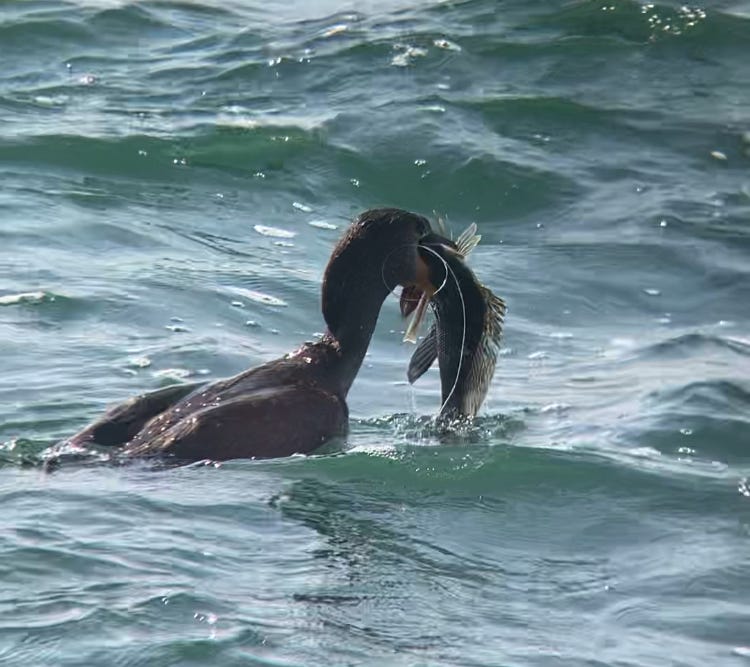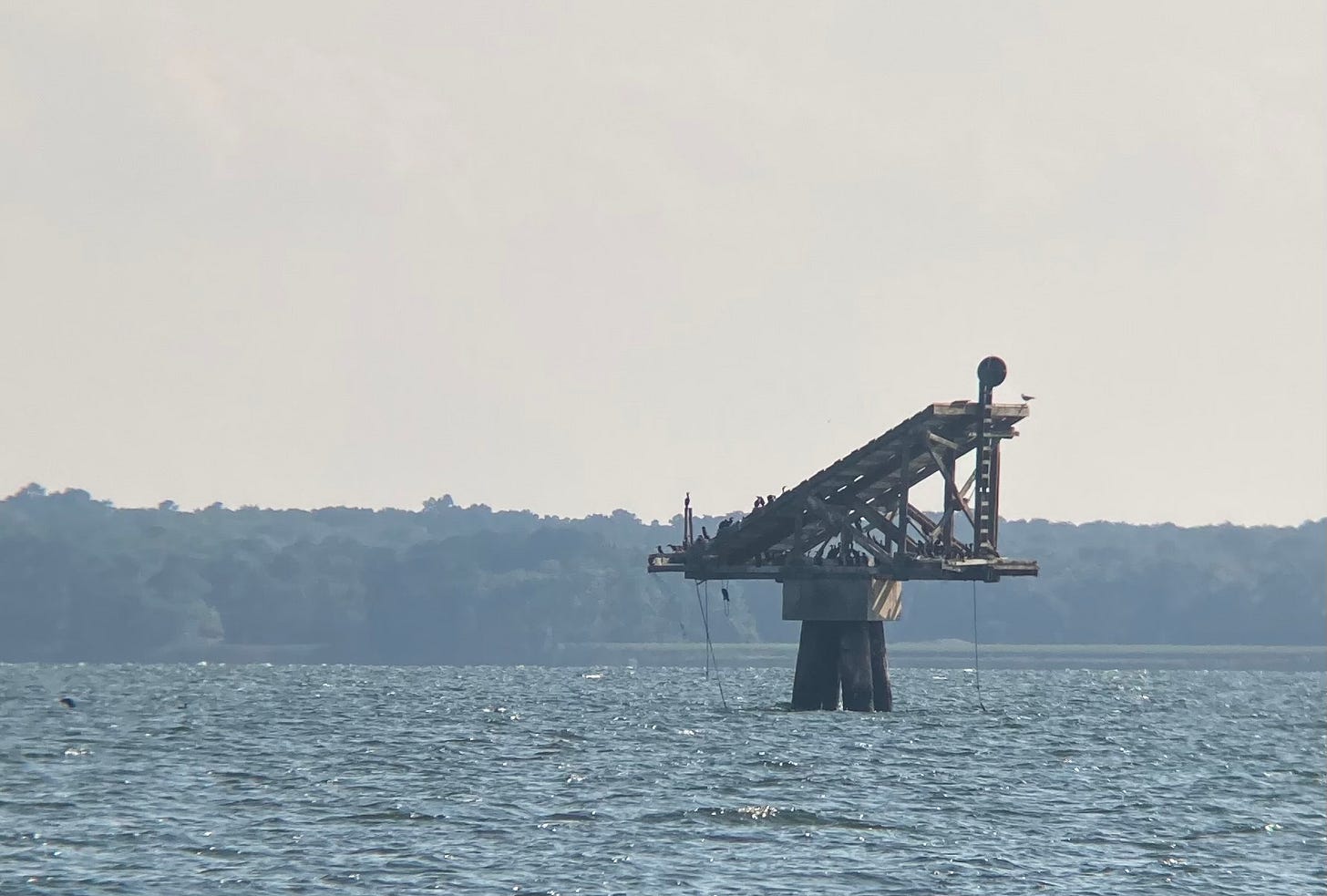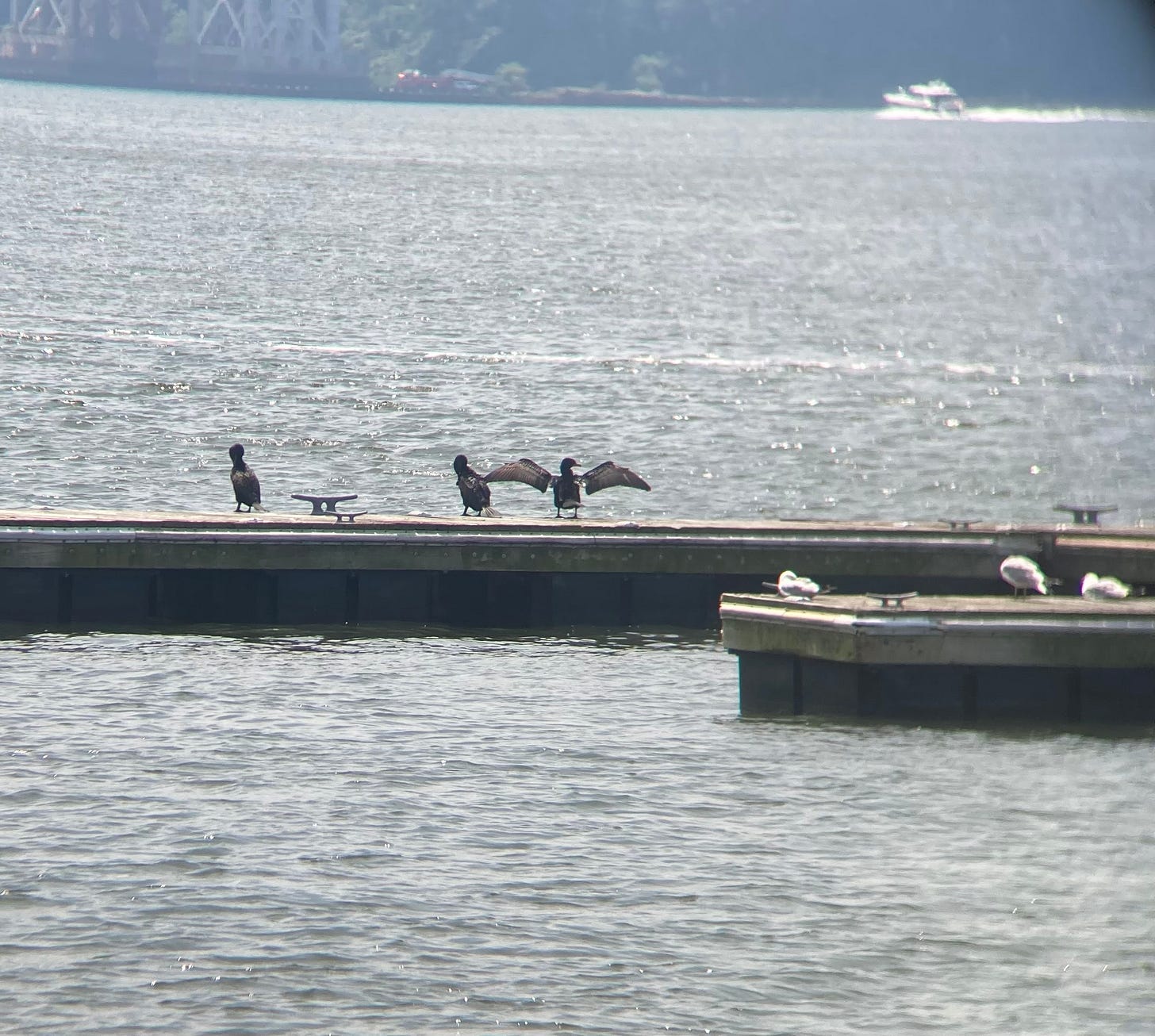If you stick around at Landlubber, you’ll get a lot of letters about seabirds, but double-crested cormorants are special to me. They aren’t the deepest divers, or the fastest swimmers, or the birds that travel the farthest out into the open ocean, and they certainly aren’t the rarest or most inaccessible seabirds. They’re a sort of eerie every-bird of coastal waters, and their natural, unfussy way of getting by on the shore is exactly the kind of vibe that Landlubber is all about celebrating.
Go to nearly any coastline in the world, and you’ll see cormorants. They’re black birds with long necks and long bills that have hooked tips. They like to perch on pilings, rocks, sandbars, channel markers, lighthouses, oil rigs, and just about anything else that juts up from the water. There are forty or so species, but double-crested Cormorants are the common ones near me. They’re named for two ear tufts you can sometimes see poking out from their heads during breeding season, but I don’t have any photos that show those.
These birds dive for their dinners, hunting fish underwater, and if the number of cormorants around me is any indication, they’re pretty good at it! They’ve done well for themselves, at least as far as seabirds go,1 and unlike the gulls (and parrots) that have thrived in certain places at least in part because of people, eating trash and stealing food, cormorants seem to get by in spite of us. We‘ve messed up the inshore coastal waters and lakes they live in, polluting the water and taking too many of the fish they depend on. Sometimes, we’ve even subjected them to deliberate persecution, killing the birds en masse at the behest of fishers who view them as competition. Double-crested cormorants don’t really need anything from us, but they’re around people a lot because their habitat overlaps with ours, which mostly ends up being bad news for them.

One way that they stand out from their seabird cousins is that while just about every other type of water bird has evolved feathers that keep water out, cormorants evolved feathers that soak it right up. Puffins, gannets, ducks, and gulls all have adaptations that repel water. The hairs (or, if we’re being technical, barbs) on most seabird feathers are tightly packed along the shafts, sealing gaps like gaskets on a space suit. Most of them also excrete oils that they preen into their plumage to give themselves a natural hydrophobic sheen. Dip a duck’s feather in the water, pull it back up, and it will be pretty dry. But the hairs on cormorant feathers are distributed loosely, especially towards the ends of the feathers, which allows water to seep right in. They preen some oil into their feathers too, but much less, and usually just on the inner layer. As a result, they get soaked when they swim.
Underwater, being saturated like that has big advantages. Cormorants maneuver extremely well while they’re swimming, and don’t need to waste energy fighting to stay down. But there are trade-offs with any evolutionary adaptation, and cormorants pay a high price for that underwater agility. Soggy means heavy, and feathers that are full of water make flying strenuous and energy intensive. After cormorants are done fishing, you’ll often see them perched with their wings spread out, waving them back and forth to air dry them before they fly off. The loose space between the tiny hairs on their feathers also allows air to pass through, requiring them to work harder as they flap through the sky (one naturalist I know compared their rushed wingbeats that don’t seem to propel them very well to a cyclist pedaling away furiously on a bicycle in low gear). They compensate by flying right above the water to get some pushback from the surface, and in groups, especially during migration, they tend to move in a “v” like Canada geese to reduce drag. One species, the flightless cormorant, that lives in the Galápagos Islands has solved those problems by giving up flight altogether, allowing their wings to atrophy and become appendages exclusively for steering underwater.
When it comes to seabirds, scientists are still uncovering fossils, poring over molecular and genetic data, and debating the finer points of the family tree. Some of that stuff is over my head but: these animals are, for the most part, related to one another. Puffins and penguins and auks and gannets all share a seabird ancestor–a little diver that probably wasn’t so different from a cormorant. The majority of these birds have since changed a lot, making themselves oilier, lighter, and sleeker. Many have evolved to swim with their wings, or regulate their buoyancy by expelling air trapped in their feathers. If penguins, with their smooth hydrodynamic skin, their insulating blubber, and their sleek, torpedo-shaped bodies, epitomize the upgraded seabirds, cormorants still do things the old way. They’re the guy driving an old tractor in the Indy 500, or, if you’d prefer a maritime metaphor, crossing the Atlantic in a tin can of a canoe. They might not swim to Antarctica to nest in the frigid ice, or have their own cottage industry of documentary filmmakers, but that doesn’t mean they aren’t hardy. I’ve seen a cormorant rookery, or colony, below an aerial target for fighter pilots in training, with the birds raising chicks in the rafters of a huge bullseye that pilots shoot ordnance at from the sky during training exercises.

Because there are so many cormorants around, I sometimes overlook them, opting to pay more attention to flashier, rarer seabirds and shorebirds, but the cormorants always catch my eye and draw me back in. Even among swarms of gannets that drop out of the sky like missiles on windy days, or the shearwaters that are perfectly shaped to glide over the waves without moving their wings, you’ll see these scrappy black birds competing at the margins, bobbing up to wrestle fish down their throat and then dropping back down into the frenzy, grinding it out fish by fish. They’re the anti-prima-donnas of the seabird world, asking for almost nothing and seemingly content (or at least resigned) to share their part of the water with us.
Quick note: my NYCBA walk in Marine Park tomorrow is CANCELLED DUE TO WEATHER. There will be no walk tomorrow morning! There wasn’t any official registration on the Bird Alliance website, so there’s no way for me to email everyone who was planning on coming, but if you see this, and you know someone who was planning on going, please pass the message along (and then tell them to subscribe!) The walk may be rescheduled, in which case I’ll update you. Okay: cormorants!
Big caveat here: to say that a seabird has “done well” basically means that they’ve declined at a slower rate than other seabirds, many of which have pretty bleak conservation outlooks Even among cormorants, there are exceptions to that modest success, with a handful of endangered species scattered around the world. It’s pretty clear from 19th century accounts that there were many more of these birds just a century or so ago.









I'm glad I'm not the only one who finds them eerie. They're always perched on jetties and pilings looking like judgy sentries when you swim by.